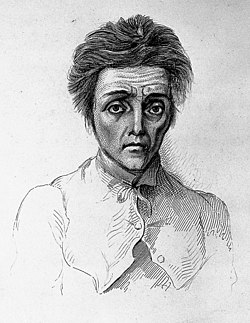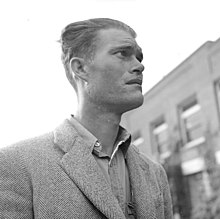User:Aliyh/sandbox
| Anxiety and women | |
|---|---|
 | |
| A patient diagnosed with Paranoia from The Physiognomy of Mental Diseases by Alexander Morison (1843) | |
| Specialty | Psychiatry, psychology |
| Frequency | = |
It is a mental state in which patients are incapable of coping with future events.[1] Anxiety is a prevalent mental disorder, which in turn poses a challenge to the patient. In positive psychology, Anxiety is defined as a mental disorder triggered by a difficult situation for which the patient does not have vital coping skills.[2] Individuals' expectations and feelings towards certain situations tend to be unrealistic, illogical, and exaggerated. Patients deem these situations as unavoidable or uncontrollable.[3] There are many types of anxiety such as panic disorder, social anxiety, specific phobias, Generalized anxiety disorder (GAD), Obsessive-compulsive disorder (OCD), and post-traumatic stress disorder (PTSD).[4]
| Part of a series on |
| Emotions |
|---|
  |

Symptoms[edit]
There are a variety of anxiety symptoms including physical, behavioral, emotional, and cognitive symptoms. Physical anxiety symptoms include shortness of breath, sweating, an increased heart rate, dizziness, fainting, trembling, muscle tension, and nausea. Behavioral symptoms include withdrawal and avoidance behavior. Patients may become overly attached to persons or places where they feel safe. Daily activities are also affected and limited. Finally, Emotional symptoms include nervousness, extreme fear, distress, apprehension, and feeling overwhelmed.[5]
Risk factors[edit]
Peripartum and pregnancy[edit]
They are sensitive periods when anxiety levels rise.[6] Anxiety levels during postpartum period fluctuate. Anxiety symptoms decrease starting from the first trimester to three months postpartum. On the other hand, it increases to thirty months postpartum.[7] Young women with a history of anxiety, premenstrual syndrome, or depressive disorders are more likely to have anxiety during the peripartum period. Young women with the Operative Vaginal Delivery, unintended pregnancy, physical or sexual trauma experience, low education, and low social support are at high risk for anxiety.[6] Meijer et al., 2014 have shown that pregnancy-related events (e.g. Antenatal testing) increase Antenatal anxiety. On the other hand, non-pregnancy related events also increase anxiety symptoms (loss of a loved one).[8]
Menopause[edit]
Menopause is accompanied with estrogen deficiency, which in turn contributes to risk for anxiety. Evidence showed that women with low anxiety premenopausally have a higher risk of severe anxiety; On the other hand, women with high anxiety premenopausally are not at risk.[9] Menopause symptoms can be mitigated by bioidentical estrogen.[10]
Menstrual cycle[edit]
Recent research has investigated the relationship between fluctuations in progesterone during menstrual cycle and anxiety. 100 polish women and 61 American women were asked to provide Saliva samples and report their anxiety at three phases during menstrual cycle; the results suggested that women with higher average progesterone levels across the menstrual phases have high anxiety than other women with low progesterone levels.[11]
Gender disparities[edit]
Women are twice as likely to have anxiety as men. Gender disparities are caused by many factors such as genetic differences, pregnancy, menopause, menstrual cycle, childbirth . The period between puberty and menopause, women are more susceptible to the particular type of anxiety (e.g. GAD or panic disorder).[12]

Intervention[edit]
CBT is more effective than other psychological or pharmacological treatments in dealing with anxiety symptoms.[14] According to a recent meta-analysis, there is strong evidence that CBT surpasses other therapies for anxiety disorder. The study also recommends CBT to be the first psychotherapeutic option for anxiety.[15] Selective serotonin reuptake inhibitors (SSRIs) are also helpful for many anxiety disorders. There are a variety of lifestyle changes that can mitigate anxiety including regular exercise, regular sleeping patterns, social or partnership support, stopping smoking. Well understanding of the risk factors and Patient Education are also helpful.[16]
Treatment and sessions[edit]
CBT sessions may involve a single patient or a group of patients. It may be accompanied by self-help books.[16] It usually involves 5-20 sessions between the therapist and the patient on a weekly or biweekly basis. In the first four sessions, the therapist checks the best approaches to help the patient. The therapy focuses on the present and the past events to help the therapist have a comprehensive understanding of the best methods to deal with anxiety.
CBT strategies for Anxiety treatment[edit]
A variety of CBT interventions for anxiety treatment are available. We will discuss some of them.
Cognitive Restructuring[edit]
It is a treatment approach to learning how to determine and dispute cognitive distortions.[17] They are maladaptive or irrational thoughts that disrupt rational thinking and contribute to anxiety. Cognitive distortions include over-generalisation, all-or-nothing thinking, exaggeration, and emotional reasoning, which in turn lead to anxiety.[18]
Relaxation techniques[edit]
It is a useful technique especially in the initial phases of anxiety. Relaxation reduces muscle tension, blood pressure, heart rate, and respiratory rate, which in turn mitigates stress or anxiety.[19] Formal and passive relaxation exercise is performed while lying or sitting including Meditation, Deep breathing, Autogenic training, etc.[20] Relaxation techniques can be accompanied with music, prayers, walking, yoga, and gardening.[20]
Mindfulness[edit]
Based on a recent meta-analysis, Mindfulness is an effective approach to anxiety treatment.[21] According to (Linda, 2016), mindfulness is a meditative approach to anxiety treatment. Mindfulness is an intervention aiming to encourage openness, acceptance, and curiosity, while it urges patients to have a non-judgmental awareness of the current experience including patient's sensations, consciousness, thoughts, and the whole environment.[22] Mindfulness utilises cognitive behavioral technique to break the vicious cycle of anxiety and the associated negative thoughts (e.g. exaggerated panic), which in turn leads to better control of the patient anxiety level or negative thoughts.[22]
Exposure technique[edit]
As patients progress during treatment, patients can better control their thoughts and feelings using different CBT techniques including mindfulness, relaxation, and more importantly exposure technique. Exposure training is a useful technique aiming to help patients face situations which they have always avoid. Exposure intervention involves subjecting patients to challenging situations associated with their anxiety, which in turn helps to confront their fears and negative thoughts. Finally, patients learn to neutralize their unjustified fear.[23]
Exposure techniques include two main types:
Interoceptive exposure[edit]
It is a type of exposure aiming to help the patient overcome the exaggerated interpretations made during anxiety or the panic attack. Patients are provided with step by step procedures to help them respond positively towards their exaggerated thoughts or feelings. It also helps them to react in a relaxed manner, which in turn leads to a positive effect. Exposure technique also utilizes certain activates (e.g. physical exercises) to help trigger the symptoms of anxiety such as a swivel chair to handle the feeling of dizziness.[24]
In vivo exposure[edit]
Anxiety is triggered by specific situations which are avoided by patients. In-vivo exposure helps patients by encouraging patients to face their fear, challenging situations, or activity. Patients with social phobia are encouraged to give a public speech in front of an audience.[25]
Two main types of in-vivo exposure are available:
Graded exposure[edit]
The therapist helps the patient construct an exposure fear list, in which situations are ranked according to their severity. The therapist starts with the less difficult situations and moves gradually to the most challenging situations.[25]
Flooding[edit]
It involves an exposure fear hierarchy, in which situations are ranked in descending order. The list starts with the most challenging situations and ends with less challenging tasks. Ballegooijen et al. showed that in-vivo exposure is useful when it prolongs for a long time, which in turn highlights the importance of repeating exposure frequently.[26] Patient's behaviour should be monitored to assess improvements during treatment.[27]
Stress reduction[edit]
As reported by (Lu, 1994),[28] life events and stressors contribute to anxiety, which In turn indicates that they can predict anxiety. For some patients, eliminating life stressors besides other strategies contribute to anxiety treatment.
Stress elimination using CBT includes two main strategies:
· The therapist is recommended to help patients react to stressful situations quietly and in a relaxed way.
· Patients are recommended to reduce the amount of stress in their daily life, which in turn improves mental health.
Bioidentical Hormone Replacement Therapy for menopausal anxiety[edit]
It is an alternative option that may be efficacious as well as being safe, especially when it is under doctor's supervision. Unlike traditional hormonal therapies, Bioidentical Hormone Replacement uses hormones that are identical to the body's hormones, which in turn makes it difficult to be patented as drugs. Ruiz et al. conducted an observational cohort study to evaluate the effectiveness of compounded Bioidentical Hormone Replacement Therapy. Compounded BHRT was given to women between the ages of 18-89 for seven years. The study examined therapeutic outcomes, comorbidities, and hormone therapies. They were given an amount which is identical to the premenopausal females in the second part of the study. The study concluded that Bioidentical hormones are safe, effective, and helpful in reducing menopausal anxiety symptoms.[29]
See also[edit]
References[edit]
- ^ Barlow, David (2000). "Unraveling the mysteries of anxiety and its disorders from the perspective of emotion theory". American Psychologist. 55 (11): 1247–63. doi:10.1037/0003-066X.55.11.1247. PMID 11280938.
- ^ Csikszentmihalyi, Mihaly (1998). Finding Flow: The Psychology of Engagement with Everyday Life. Basic Books. ISBN 9780465024117.
- ^ Barrett, Lisa; Lewis, Michael; M, Jeannette (2018). Handbook of emotions. ISBN 9781462536368. OCLC 1015859797.
- ^ Black, Elisa (2017). The Anxiety Book: Information on panic attacks, health anxiety, postnatal depression and parenting the anxious child. Sydney, NSW: Hachette Australia.
- ^ Robinson, Theresa (2010). Social Anxiety: Symptoms, Causes, and Techniques. Nova Science Publishers.
- ^ a b Martini, Julia; Petzoldt, Johanna; Einsle, Franziska; Beesdo-Baum, Katja; Höfler, Michael; Wittchen, Hans-Ulrich (2015). "Risk factors and course patterns of anxiety and depressive disorders during pregnancy and after delivery: A prospective-longitudinal study". Journal of Affective Disorders. 175: 385–395. doi:10.1016/j.jad.2015.01.012. ISSN 0165-0327.
- ^ Figueiredo, Bárbara; Conde, Ana (2011). "Anxiety and depression in women and men from early pregnancy to 3-months postpartum". Archives of Women's Mental Health. 14 (3): 247–255. doi:10.1007/s00737-011-0217-3. ISSN 1434-1816.
- ^ Meijer, Judith L.; Bockting, Claudi L.H.; Stolk, Ronald P.; Kotov, Roman; Ormel, Johan; Burger, Huibert (2014). "Associations of life events during pregnancy with longitudinal change in symptoms of antenatal anxiety and depression". Midwifery. 30 (5): 526–531. doi:10.1016/j.midw.2013.06.008. ISSN 0266-6138.
- ^ Bromberger, Joyce T.; Kravitz, Howard M.; Chang, Yuefang; Randolph, John F.; Avis, Nancy E.; Gold, Ellen B.; Matthews, Karen A. (2013). "Does risk for anxiety increase during the menopausal transition? Study of Women's Health Across the Nation". Menopause: The Journal of The North American Menopause Society: 1. doi:10.1097/gme.0b013e3182730599. ISSN 1072-3714.
- ^ Ruiz, Andres D; Daniels, Kelly R; Barner, Jamie C; Carson, John J; Frei, Christopher R (2011-06-08). "Effectiveness of Compounded Bioidentical Hormone Replacement Therapy: An Observational Cohort Study". BMC Women's Health. 11 (1). doi:10.1186/1472-6874-11-27. ISSN 1472-6874.
{{cite journal}}: CS1 maint: unflagged free DOI (link) - ^ Reynolds, Tania; Makhanova, Anastasia; Marcinkowska, Urszula (2017). "Progesterone and women's anxiety across the menstrual cycle". Hormones and Behavior. 102. doi:10.1016/j.yhbeh.2018.04.008.
- ^ Altemus, Margaret; Sarvaiya, Nilofar; Epperson, C. Neill (2014). "Sex differences in anxiety and depression clinical perspectives". Front Neuroendocrinol. 35 (3): 320–330. doi:10.1016/j.yfrne.2014.05.004.
- ^ Scarre C (1995). Chronicle of the Roman Emperors. Thames & Hudson. pp. 168–9. ISBN 978-5-00-050775-9.[page needed]
- ^ Reinecke, Andrea; Thilo, Kai; Filippini, Nicola; Croft, Alison; Harmer, Catherine J. (2014). "Predicting rapid response to cognitive-behavioural treatment for panic disorder: The role of hippocampus, insula, and dorsolateral prefrontal cortex". Behaviour Research and Therapy. 62: 120–128. doi:10.1016/j.brat.2014.07.017. ISSN 0005-7967.
- ^ Otte, Christian (2011). "Cognitive behavioral therapy in anxiety disorders: Current state of the evidence". Dialogues Clin Neurosci. 13 (4): 413–421.
- ^ a b Stein, MB; J., Sareen (2015). "CLINICAL PRACTICE. Generalized Anxiety Disorder". N Engl J Med. 373 (21): 2059–68. doi:10.1056/NEJMcp1502514.
- ^ Gladding, Samuel (2012). Counselling : a comprehensive profession. Pearson Canada. ISBN 9780138009892. OCLC 697934419.
- ^ Martin, Ryan C.; Dahlen, Eric R. (2005). "Cognitive emotion regulation in the prediction of depression, anxiety, stress, and anger". Personality and Individual Differences. 39 (7): 1249–1260. doi:10.1016/j.paid.2005.06.004. ISSN 0191-8869.
- ^ Michel., Hersen, (2013). Handbook of evidence-based practice in clinical psychology, adult disorders. Wiley. ISBN 9781118144756. OCLC 864906025.
{{cite book}}: CS1 maint: extra punctuation (link) CS1 maint: multiple names: authors list (link) - ^ a b Seaward, Brian (2018). Managing stress : principles and strategies for health and well-being. Burlington, MA : Jones & Bartlett Learning. ISBN 9781284126273. OCLC 992971791.
- ^ Davies, Sue (2011-04-05). "The effect of mindfulness-based therapy on anxiety and depression: a meta-analytic review". Primary Health Care. 21 (3): 14–14. doi:10.7748/phc.21.3.14.s12. ISSN 0264-5033.
- ^ a b Bishop, S. R. (2004-08-01). "Mindfulness: A Proposed Operational Definition". Clinical Psychology: Science and Practice. 11 (3): 230–241. doi:10.1093/clipsy/bph077. ISSN 1468-2850.
- ^ Payne, Laura; White, Kamila S.; Gallagher, Matthew W.; Woods, Scott W.; Shear, M. Katherine; Gorman, Jack M.; Farchione, Todd J.; Barlow, David H. (2015). "SECOND-STAGE TREATMENTS FOR RELATIVE NONRESPONDERS TO COGNITIVE BEHAVIORAL THERAPY (CBT) FOR PANIC DISORDER WITH OR WITHOUT AGORAPHOBIA-CONTINUED CBT VERSUS SSRI: A RANDOMIZED CONTROLLED TRIAL". Depression and Anxiety. 33 (5): 392–399. doi:10.1002/da.22457. ISSN 1091-4269.
- ^ Starcevic, Vladan (2010). Anxiety disorders in adults : a clinical guide. Oxford University Press. ISBN 9780199708994. OCLC 615639712.
- ^ a b Abramowitz, Jonathan; Deacon, Brett; Whiteside, Stephen (2012). EXPOSURE THERAPY FOR ANXIETY : principles and practice. GUILFORD. ISBN 1462539661. OCLC 1055687222.
- ^ van Ballegooijen, Wouter; Klein, Britt; Lindefors, Nils (2016), "ICBT for Panic Disorder and Agoraphobia: From the Computer at Home to Real-Life 'In Vivo' Exposure", Guided Internet-Based Treatments in Psychiatry, Springer International Publishing, pp. 33–52, ISBN 9783319060828, retrieved 2018-11-19
- ^ Sadock, Benjamin; Sadock, Virginia; Ruiz, Pedro (2017). Kaplan & Sadock's Concise Textbook of Clinical Psychiatry. Lippincott Williams & Wilkins. ISBN 9781496345257.
- ^ Lu, Luo (1994). "University transition: major and minor life stressors, personality characteristics and mental health". Psychological Medicine. 24 (01): 81. doi:10.1017/s0033291700026854. ISSN 0033-2917.
- ^ Ruiz, Andres D; Daniels, Kelly R; Barner, Jamie C; Carson, John J; Frei, Christopher R (2011). "Effectiveness of Compounded Bioidentical Hormone Replacement Therapy: An Observational Cohort Study". BMC Women's Health. 11 (1). doi:10.1186/1472-6874-11-27. ISSN 1472-6874.
{{cite journal}}: CS1 maint: unflagged free DOI (link)
External links[edit]
 Media related to Aliyh/sandbox at Wikimedia Commons
Media related to Aliyh/sandbox at Wikimedia Commons- Aliyh/sandbox at Curlie
Category:Emotions Category:Mental states in Csikszentmihalyi's flow model
